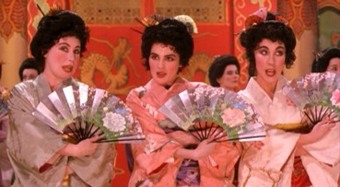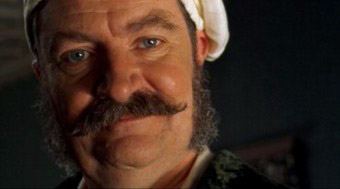|
Mike
Leigh has over the years carved himself a very particular
niche via a body of films that includes such gems as Abigail's Party, High Hopes, Naked, Life
is Sweet and All or Nothing,
works that examine private lives in turmoil with a mixture
of unnerving accuracy, tragedy-tinged character comedy
and open parody. Leigh's method of script construction
is famously unusual: he devises the story and characters
(his early films carried the credit "devised by Mike
Leigh"), selects his actors, works with
them for some weeks encouraging them to improvise freely,
then constructs the final screenplay around the results.
When it works best – as in the magnificent Life
is Sweet – it produces films that are both an exaggeration of reality and completely true to life in a way that marks
Leigh as one of this country's finest and most important film-makers. So
it came as something as a surprise when it was first announced
that was making a film that was not
a slice of modern social observation located in suburban London, but a biographical backstage musical
set in Victorian times. Could this possibly be a Mike
Leigh film? The Mike Leigh? As it turns out, yes. Leigh
has in his time directed extensively for the stage as
well as for film, and his passion for the theatre
comes across here in spades.
Topsy-Turvy revolves around the hugely successful (and influential)
partnership of William S. Gilbert and Arthur Sullivan
as their latest production, Princess Ida, opens at London's
Savoy Theatre. Reviews, though favourable, highlight a
lack of evolution from their previous works, and audiences
soon dwindle, not helped by a particularly unpleasant summer heatwave. Gilbert
expresses frustration and Sullivan declares that he will
write no more comic operas and instead follow his ambition
to create the grand opera he believes the public now expects
of him. But a chance visit to a Japanese exhibition in
London – which includes a kendo demonstration and a Kabuki Theatre
performance of a scene from The Forty-Seven Ronin – inspires Gilbert to create a script that re-unites him with his long-time collaborator, and becomes what was to prove one of their very greatest successes,
The Mikado.

Biographical
films, especially historical ones, are tricky beasts to get right,
as there seems to be an almost universally accepted template for their presentation
that most film-makers seem to feel obliged
to follow. At its worst this is stiff, reverential, visually
impressive and dull, but just five minutes into Topsy-Turvy you just know that Leigh has no intention of walking this
road. Even the first shot, of theatre workers meticulously
checking the seats for the opening night of the new opera,
seems to proclaim that this one is going to break the mould.
Where
the film does share common ground with Leigh's other work
is in its concentration on character, its lively
dialogue, its extraordinary performances, and the frankly
jaw-dropping level of character detail. Selling Leigh's improvisational approach to
the uninitiated is a job and a half here, especially given the period setting and
subject matter and the fact that film runs
for 152 minutes. In addition to that, the single paragraph plot summary above
pretty much covers the essentials – the rest is all about character
and performance, and we are almost an hour into the film
before Gilbert even finds his unexpected inspiration.
But therein lies the film's very real delight, in allowing us to be privy
to the private lives of these public figures, in the backstage
camaraderie and ego-duels, in following the process from
the moment of inspiration to the completed opera. Leigh
makes it all work so well because he refuses to sugar-coat the lives he is portraying – Sullivan is shown to be struggling
with kidney disease and bored with creating the very works
that have brought him his fame, whilst Gilbert comes across as self-centred and
relentlessly downbeat about just about everything ("There's
something inherently disappointing about success,"
he morosely states after The Mikado's triumphant first night). It's an attitude his wife Kitty finds increasingly wearisome, despite her efforts to maintain a devoted and chirpy
front.
Elsewhere, Leigh subtly links these issues to the social
conditions of the time – as Kitty uses theatrical metaphor
to communicate to her husband her despair at their childless
and sexless marriage, Sullivan's mistress Fanny makes
her own arrangements for another abortion in a society
that shuns children born out of wedlock. This prejudice has also ensured that lead soprano and single mother Leonora Braham is unable to
find a male suitor, a situation that has driven her to drink,
an addiction that is starting to threaten her career.
All
of which may make Topsy-Turvy sound like
a dark and even depressing tale, but nothing could be
further from the truth. These elements are weaved organically
into a film that is infused with a passion and a love for theatre,
and one that must rank as Leigh's most uplifting and joyous work to date. Leigh combines a sly narrative
economy – Gilbert's moment of fourth-wall breaking moment of inspiration is followed by an imagined musical number and a sequence in which he reads out the completed script to a
delighted Sullivan – with extended scenes in which
we just sit back and watch the performers explore their characters.
And not for one second is it even remotely dull or drawn out.
Leigh has complete faith in his material and his actors,
and neither let him down. This blend of trust and talent gives birth to scenes that are
an absolute joy to watch, principally for the character detail and what the performers bring to the table: Sullivan
energetically running though a musical number with his
three male leads; the eight minute rehearsal sequence
in which Gilbert attempts to iron out the performance eccentricities
of his cast; the hilarious attempts
to make the leading ladies walk in 'a Japanese manner' that culminates in a glorious rendition of Three
Little Maids From School Are We... this list goes
on and on.

Without doubt the film's principal pleasure lies in its performances, and rarely have I seen a film with such consistently marvellous
acting across the board. Every character makes their considerable mark, especially in ensemble scenes,
where each line is played to a finely judged hilt. Selecting individual
cast members for specific praise is an almost redundant
task, but special mention must nonetheless go to Allan
Corduner, who is just magnificent as the effervescent
Sullivan, with his skill as a pianist also put to splendid use. He is given a serious run for his money
by Leigh irregular Jim Broadbent as Gilbert, Wendy Nottingham
as the no-nonsense Helen Lenoir ("The more I see
of men, the more I admire dogs"), Ron Cook as D'Oyly
Carte ("Well I don't know about you, but speaking
for myself I could murder a pork chop"), Lesley
Manville as the resiliently put-upon Kitty, Martin Savage
as George Grossmith, Timothy Spall (another Leigh irregular)
as Richard Temple, and Kevin McKidd as Durward Lely, a
Scotsman who feigns an aristocratic English accent when
in the theatre, which he happily drops when eating with friends or
intimidating staff. As if that weren't enough,
every one of them holds their own in their energetic performances of Gilbert and Sullivan musical numbers that
pepper the film, keenly illustrating the sheer breadth of talent required of theatre performers worth their salt.
Topsy-Turvy may on the surface seem an atypical Mike Leigh film and
in many ways it is, but it's also his most accessible,
and demonstrates many of the qualities that have
made Leigh one of the key film-makers of his generation.
In the end, though, it comes unreservedly recommended
not for the man behind it, but for what it is, a multi-layered,
beautifully performed, joyously exuberant celebration
of the world of musical theatre, and of two of its most celebrated,
talented and fascinating figures.
A
clean, bright transfer that nevertheless loses gobs of points
through being non-anamorphic. This was particularly irritating
on its release because it marked a dual standard on the part
of distributor Pathe, who have released anamorphic prints of big
Hollywood films such as The Fifth Element but consistently failed to deliver the goods on smaller works
such as this (though let's not forget that Topsy-Turvy won two Oscars and was nominated for two more). It's a particular
sore point because the American region 1 DVD sports the anamorphic
print that this one should have had.
The
5.1 sound mix is bright and full, but weighted to the front
sound stage, which is fully utilised. A bit more rear
speaker action would have provided a more involving mix, but
otherwise no complaints. The music otherwise sounds terrific
and the dialogue is always crystal clear.
Apart
from the expected theatrical trailer (though this is really
well cut together, if technically inferior to the main feature in terms
of picture and sound), there is only one, and it's this
alone that gives Pathe's disk an edge over its anamorphic
region 1 counterpart: a director's commentary track. Not
only was this the first Mike Leigh commentary to appear
on DVD, it's quite simply one of the most compelling and
informative I have yet heard. Leigh provides an absolute
wealth of background detail about not just the film, but
the lives of the main characters, the music chosen by arranger
Carl Davis, and the factual elements of scenes that it would be
easy to assume were fictionalised. There are almost no dead
patches, Leigh only going quiet at the end when, as he says,
the scenes work so well there is simply nothing for him
to add.
Topsy-Turvy is a marvelous
film, a gorgeously performed and detailed character piece
that reflects Leigh's own love of theatre and has more character
detail in one scene than most period films do in their entire
length. Despite pushing plot to the background, it creates
such a sense of pace through the performances, the music,
the rich layering and energy with which it is assembled,
that the 152 minute running time literally flies by. The
result is one of the best biographical films I have ever
seen, and a text book example of how it is still possible
to make a vibrant and original work from seemingly familiar
material.
Whether
you choose to buy this disc or the region 1 equivalent will
depend on your fondness for director's commentaries. If
you do not care for them then go for the region 1 – it has
an anamorphic transfer, a featurette and a photo gallery
to recommend it. But if you really want to know more about
the background to this film, about how it was made, researched
and cast, then Leigh's commentary is a must, and the region
2 disc wins on that alone.
|